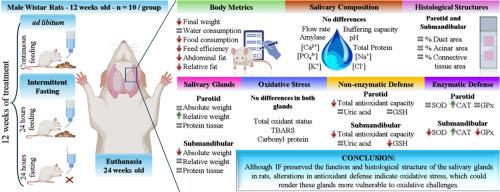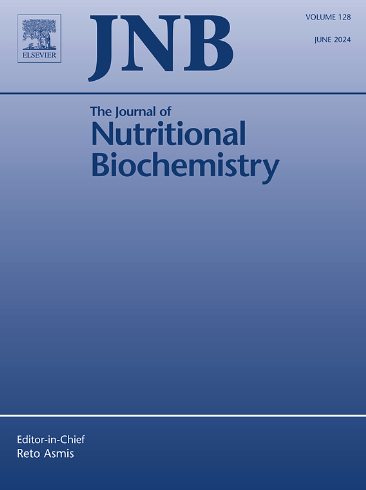Intermittent fasting preserves the function and histological structure but induces oxidative stress in the salivary glands of male Wistar rats
IF 4.9
2区 医学
Q1 BIOCHEMISTRY & MOLECULAR BIOLOGY
引用次数: 0
Abstract
Studies indicate that dietary patterns influence the function and redox balance of salivary glands. This study examined the effects of intermittent fasting (IF) on the function, histological structure, and redox balance of the salivary glands. Twenty 12-week-old male Wistar rats were randomized into two groups: ad libitum (AL), with continuous access to water and chow, and IF, subjected to 24-h fasting on alternate days for 12 weeks. At the end, pilocarpine-induced saliva was collected to analyze flow rate and biochemical composition, while histological structure and redox balance were assessed in the parotid and submandibular glands. IF reduced final body weight and the absolute weight of the submandibular gland while increasing the relative weight of the parotid gland. Salivary flow rate and biochemical parameters, including pH, buffering capacity, amylase, total protein, and electrolyte concentration, were similar between groups. The areas of acini, ducts, and stroma, as well as total oxidant status and markers of lipid and protein oxidative damage, did not differ between groups in either salivary gland. However, IF distinctly affected the antioxidant defense mechanisms of the salivary glands, reducing total antioxidant capacity and increasing catalase (CAT) activity in the parotid glands, while in the submandibular glands, there was higher CAT activity accompanied by reduced superoxide dismutase, glutathione peroxidase, total antioxidant capacity, and reduced glutathione concentrations. Although IF preserved the function and histological structure of the salivary glands in rats, alterations in antioxidant defense indicate oxidative stress.

间歇性禁食可以保持雄性Wistar大鼠唾液腺的功能和组织结构,但会引起氧化应激。
研究表明,饮食模式影响唾液腺的功能和氧化还原平衡。本研究探讨了间歇性禁食(IF)对唾液腺功能、组织学结构和氧化还原平衡的影响。将20只12周龄雄性Wistar大鼠随机分为两组:AL组,连续给予水和食物;IF组,隔日禁食24小时,连续12周。最后,收集匹罗卡品诱导的唾液,分析其流速和生化成分,同时评估腮腺和颌下腺的组织结构和氧化还原平衡。IF降低了最终体重和颌下腺的绝对重量,而增加了腮腺的相对重量。两组间唾液流速和生化参数(pH、缓冲能力、淀粉酶、总蛋白和电解质浓度)相似。腺泡、导管和间质区域以及总氧化状态和脂质和蛋白质氧化损伤标志物在两组唾液腺中均无差异。然而,IF明显影响唾液腺的抗氧化防御机制,降低腮腺的总抗氧化能力,增加过氧化氢酶(CAT)活性,而在颌下腺,CAT活性升高,同时超氧化物歧化酶、谷胱甘肽过氧化物酶、总抗氧化能力降低,谷胱甘肽浓度降低。虽然IF保留了大鼠唾液腺的功能和组织结构,但抗氧化防御的改变表明氧化应激。
本文章由计算机程序翻译,如有差异,请以英文原文为准。
求助全文
约1分钟内获得全文
求助全文
来源期刊

Journal of Nutritional Biochemistry
医学-生化与分子生物学
CiteScore
9.50
自引率
3.60%
发文量
237
审稿时长
68 days
期刊介绍:
Devoted to advancements in nutritional sciences, The Journal of Nutritional Biochemistry presents experimental nutrition research as it relates to: biochemistry, molecular biology, toxicology, or physiology.
Rigorous reviews by an international editorial board of distinguished scientists ensure publication of the most current and key research being conducted in nutrition at the cellular, animal and human level. In addition to its monthly features of critical reviews and research articles, The Journal of Nutritional Biochemistry also periodically publishes emerging issues, experimental methods, and other types of articles.
 求助内容:
求助内容: 应助结果提醒方式:
应助结果提醒方式:


